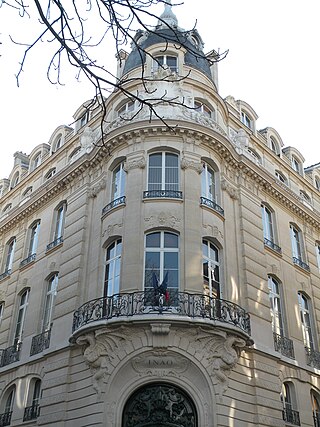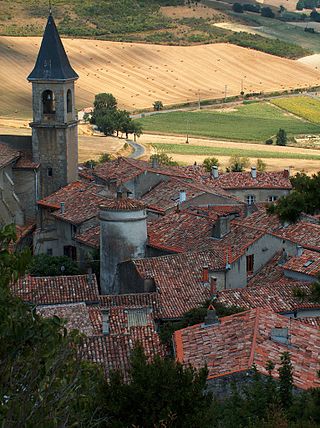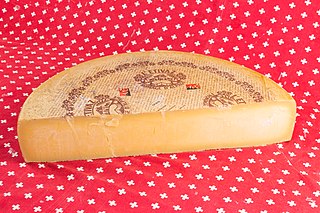
Comte Henri Marie Raymond de Toulouse-Lautrec-Monfa was a French painter, printmaker, draughtsman, caricaturist and illustrator whose immersion in the colourful and theatrical life of Paris in the late 19th century allowed him to produce a collection of enticing, elegant, and provocative images of the sometimes decadent affairs of those times.
In Spain, the denominación de origen is part of a regulatory geographical indication system used primarily for foodstuffs such as cheeses, condiments, honey, and meats, among others. In wines, it parallels the hierarchical systems of France (1935) and Italy (1963), although Rioja (1925) and Jerez (1933) preceded the full system. In foods, it performs a similar role, regulation of quality and geographical origin of products from Spain. There are five other designated categories solely for wine and a further three specifically covering food and condiments, all recognised by the European Union (EU). In Catalonia, two further categories – labelled A and Q – cover traditional Catalan artisan food products, but were not recognised by the EU as of 2007. In recent decades, the concept of the denominación de origen has been adopted by other countries, primarily in Latin America. In 2016, the use of the Denominación de Origen (DO) for wines was registered as a European Union Protected Designations of Origin/Denominación de Origen Protegida (PDO/DOP), but the traditional Portuguese term of DO can still be used legally on labels.

In France, the appellation d'origine contrôlée (AOC) is a label that identifies an agricultural product whose stages of production and processing are carried out in a defined geographical area – the terroir – and using recognized and traditional know-how. The specificity of an AOC product is determined by the combination of a physical and biological environment with established production techniques transmitted within a human community that, together, give the product its distinctive qualities. These crucial technical and geographic factors are set forth in standards for each product, including wines, cheeses and meats. Other countries and the European Union have similar labeling systems. The European Union's protected designation of origin system has now harmonized the protection of all geographical indications and their registration. When labelling wine however, producers may still use recognized traditional terms like AOC, and are not required to display the PDO and PGI logos or terms, mostly for aesthetic purposes.

Les Plus Beaux Villages de France is an independent association created in 1982 for the promotion of the tourist appeal of small rural villages with a rich cultural heritage. As of September 2016, it numbers 156 member villages.

Corbières is an Appellation d'origine contrôlée (AOC) for wine in the Languedoc-Roussillon, France, and it is this region's largest AOC, responsible for 46 per cent of the region's AOC wine production in 2005. Red wine dominates the production in Corbières with almost 95 per cent, with 3.5 per cent rosé wine and 2 per cent white wine making up the balance. Carignan is the most common grape variety. The AOC was created in 1985, covers 13,500 hectares of vineyards and produces an average of 554,000 hectoliters of wine per year, corresponding to 74 million bottles.

The mainstream quality wine regions in Spain are referred to as denominaciones de origen protegidas (DOP) and the wine they produce is regulated for quality according to specific laws, and in compliance with European Commission Regulation (CE) 753/2002. In 2016, the use of the term Denominación de Origen (DO) was updated to Denominación de Origen Protegida (DOP) by the Spanish Ministry of Agriculture, Fisheries and Food ; the traditional term of DO can still be used legally on labels, but it will eventually be replaced by DOP.

Authon is a commune in the Alpes-de-Haute-Provence department in the Provence-Alpes-Côte d'Azur region of south-eastern France.

Aubignosc is a commune in the Alpes-de-Haute-Provence department in the Provence-Alpes-Côte d'Azur region of south-eastern France.
Bagnoles is a commune in the Aude department in the Occitanie region of southern France.

Aguessac is a commune in the Aveyron department in the Occitanie region of southern France.

Saint-Quentin-Fallavier is a commune in the Isère department, and the Auvergne-Rhône-Alpes region, in southeastern France.

Lautrec is a commune in the Tarn department in southern France.
Damassine is a clear, fruit spirit, distilled from the red damson plum, produced exclusively in the Swiss Republic and Canton of Jura following appellation d'origine protégée (AOP) guidelines that require specific sourcing and production practices. Damassine is also considered an eau-de-vie, more specifically and eau de vie de prunes, and is commonly referred to as a fruit brandy contrary to the regulation defining it as a fruit spirit.
The Tarn department is situated in the southwest of France.
Vin de France is a designation for table wine from France that has been in use since 2010, when it started to replace the former vin de table category. Vin de France wines may indicate grape variety and vintage on the label, but are not labelled by region or appellation; they are labelled only as coming from France. This means that the wines are typically sold under brand names or as branded varietal wines.

In Switzerland, the appellation d'origine protégée is a geographical indication protecting the origin and the quality of traditional food products other than wines.

IGP Charentais, formerly known as vin de pays charentais up until 2009, is a French wine region and protected geographical indication. It covers the French départements of Charente and Charente-Maritime in south-west France.
The canton of Plaine de l'Agoût is an administrative division of the Tarn department, southern France. It was created at the French canton reorganisation which came into effect in March 2015. Its seat is in Sémalens.

Miel de Provence is protected by a Label Rouge associated to a protected geographical indication both for the all flowers honey and for the lavender and lavandin honey














